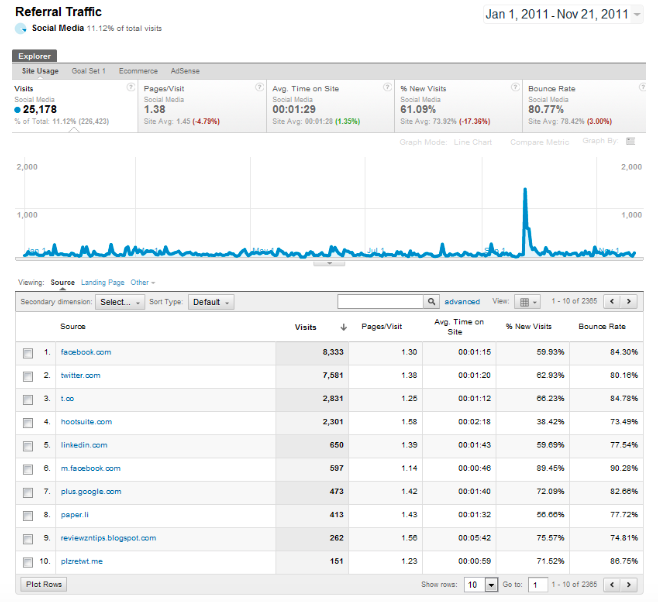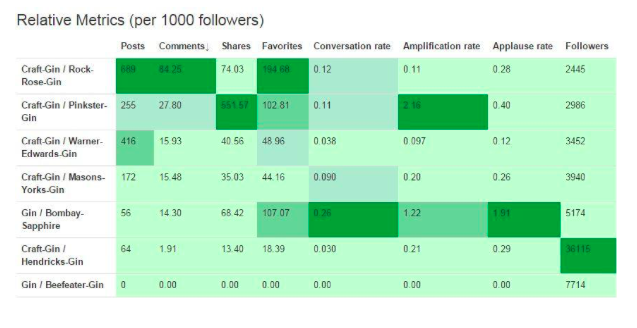As Sean Gardner rightly said, “Social Media is not just an activity; it’s an investment of time and valuable resources.”
Today, you spend a lot of effort on strategizing your social media promotions and even track them on a regular basis to know where you are going and if at all it’s worth your time, money, and cost. Frankly, I also do that, and like most companies, I do track my social media presence, however, in a more advanced manner.
In the changing circumstances of digital marketing and social sharing, I prefer to look beyond link clicks, likes, comments, shares, web referrals, and all other parameters. And what I track allows me to fill those missing gap in my social communications and empowers me to improve my social media tracking.
Here’s the 7 most significant social media metrics that you might have already been analysing. However, it’s time for a change, time to level-up your social branding. To achieve this, take a deeper look into those statistics and consider the more important figures that will boost your digital presence.
1. Referral traffic
Not all your website traffic comes from Google or other search engines. This, of course, calls for a need to determine the source of traffic that you get from other online sources, websites and social media. And the good news is, Google Analytics has recently added a specialised tab that highlights the referral traffic statistics from other social platforms. You get keyword-based visit and %visit data, over a 30-day period.
According to Forbes, social media now drives 31% of referral traffic. These are the most credible sources that provide deep insights into your social performance. It talks about website visits, page views, total number of sessions, average time spent on pages and the most frequently visited pages along with the bounce rates from each page.
Hold on!! Did I just say bounce rates? And why not. After all, it helps in calculating your ROI. We all make a common mistake of determining the ROI based on the click-through rates achieved. This means we are only considering the income against our investment and not the losses; which gives an incomplete revenue figure.
The bounce rates also tell you, if you are hitting the right people. For example, if you see higher bounce rates from your social traffic, as compared to other online traffic sources, it clearly means that you are targeting the wrong group.

How to Track Referrals and Bounce Rates?
Go to your Google Analytics account and go to the “Acquisition” tab. There, you will find “Traffic Sources”. Click on “Referrals” and “Social” to get the requisite details.
From the “Acquisition” tab, go to “All Traffic” and select “Channels”. Then, click on “Bounce Rate” button.
- Click rates on social posts
While various studies have keyed down the fact that the clicks and conversions are not virtually co-related, yet we notice a common consumer behaviour. People willing to buy our products first click on our social posts, and then on the link, which directs them to the product purchase or subscription pages. From here, we can conclude that clicks are the gateway to make purchases. It also informs us about our potential customers. According to re
Besides analysing click rates, we must think of improving the click rates of social shares. And there are three ways to it- frequency, timing, and posting in multiple sites. According to research, posting promotional content for 1-4 times on Facebook and 5-10 times on Twitter gives optimum results. We must post anywhere between 8 am to 10 am (while people are travelling to office or just in office), 2 pm to 4 pm (lunch time and leisure), and 6 pm to 12 am (that’s when most consumers are online). Posting content on affiliate sites is a clever way of enhancing trust and engaging more people.

How to track Click Rates?
Bit.ly is a simple click rate tracking tool. Use it to see which kind of social media posts are most clicked by your targets and how many of them buy your product.
2. Social share of voice
Until now, you have been tracking your mentions to know how many your fans and customers are keen on talking about you and mentioning your “name” in on the social media. No doubt this metric is worth, however, for a more valuable result; consider tracking the social share of voice. It helps you to analyze the ratio of your business mentions within the industry to that of the competitors.
As a result, you know your current standing and can assess your position with respect to your competitors. At the same time, you can ensure that you’ve taken the right direction. Regular tracking of this metric also provides effective illustrations of your social media campaigns. Thus, with time, you gradually overpower your competitors and emerge to be an industry leader.

How to track share of voice?
Use Google Analytics to generate automatic numbers of yours and your competitors’ mentions. Add all the numbers to calculate the total industry mentions. Now, find the percentage of your brand mentions.
3. Conversation rates
All this while, you have been keeping a close watch on the comments of your social posts. But, there’s more to those one liners- “Wow!! I like it”, “I have tried it out, and it’s amazing”, “My favourite product” or perhaps the one-words- “Nice”, “Wonderful” and so on and so forth. And that’s conversation, which is the ratio of per-post comment to the overall number of page likes or followers.
Let’s see an example. One social page has 100 followers of whom only 10-15 care for commenting. And there’s another with only 50 followers, and about 25-30 of them actively comment on their brand. In the first case, the conversation rate is only 10-15% whereas, in the second, it’s 50% or more. The latter is, of course, more compelling and talks about your active social media presence.
The more people get into conversations, the more they wish to associate with your brand and its other users. Conversations are also a good way to generate buzz in the online space. With everyone busy talking about your products; nothing seems to be a better gift.
How to track conversation rates?
With Social Media Analytics of SocialPilot, you can very easily know & analyze the number of comments during a specified period. You can know who are your most active contributors, likers, sharers, influencers and more and that too in a very easy to understand layout.

4. Amplification rates
When it came to your social shares, you only studied the number of shares on a daily basis (if you regularly post about your brand), or on a post basis. However, now look beyond your individual number of shares and compare those numbers to the number of your followers. Also, analyse the rate at which each follower’s share your posts in their timeline or other people within its friend list. With this, you know how much percentage of your fans is actually in love with your brand and truly love sharing your stuff with the world.
Amplification rates talk about your real fans, which are more than willing to associate with your brand and purchase your product. You increase your networks. And how does that happen? Your followers share your posts with their friends (your 1st level network), who again share with their friends (2nd level network), and so on and so forth. Calculating the amplification rate also gives an idea about brand visibility. It allows you to penetrate various geographical locations and target consumers from those regions.
How to track amplification rate?
Track the number of times your followers shared, re-tweeted, re-pinned, or re-grammed your content. Calculate the percentage of shared content to the total number of followers.
5. Applause rates
Likes were all that you knew, till date right? So did I. But now, it’s again time to map your likes to your total number followers and see how many of them are genuine to your brand. It may so happen that you are increasing your number of followers, however, there’s hardly any likes on your page. And if it so happens, you’re poor in branding. Thus, to ensure that you stand strong in applauses, and not just mere likes, analyse your applause rates.

How to track applause rates?
Track the number of likes and calculate its percentage against the total number of followers of your page.
6. Leads
And last, nonetheless the least, it’s all about business generation, which happens from leads. Social media leads are one of the key sources of developing potential targets and expanding business. While tracking leads, ensure that your shared links can also be tracked from your GA or marketing automation software.
How to track leads?
There are many ways, you can do that:
- Run a Campaign to conduct contest along with form-filling entry
- Share gated content
- Use social media ads and offer free trials and discount offers to your target audience
Conclusion
From the above metrics, by now you have understood that it’s no longer about your achievements only but how you have achieved, against what you have. Adding to that, how far or ahead you are, of your competitors. Once you assess this, you get your credibility and standing. Then, you only need to come up with good ideas to improve your social media performance and then the world becomes your kingdom.
So, pull up your socks, see where you stand, match yourself with your competitors, and conquer the minds of consumers. They are ALL YOURS!!!
Share your thoughts with us in the comments below!



